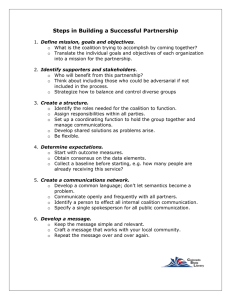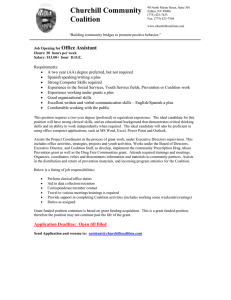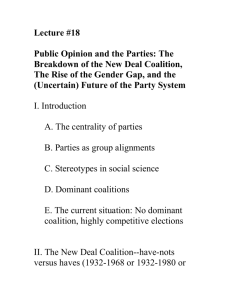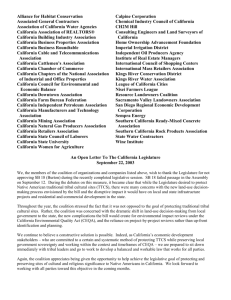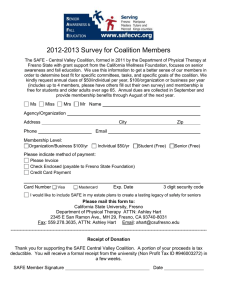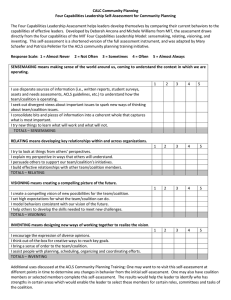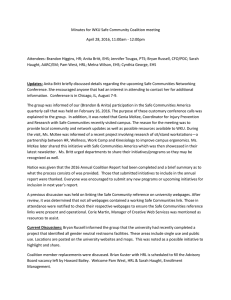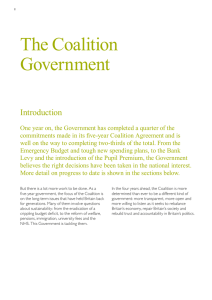Class 7 PowerPoint Team and Coalition Building
advertisement
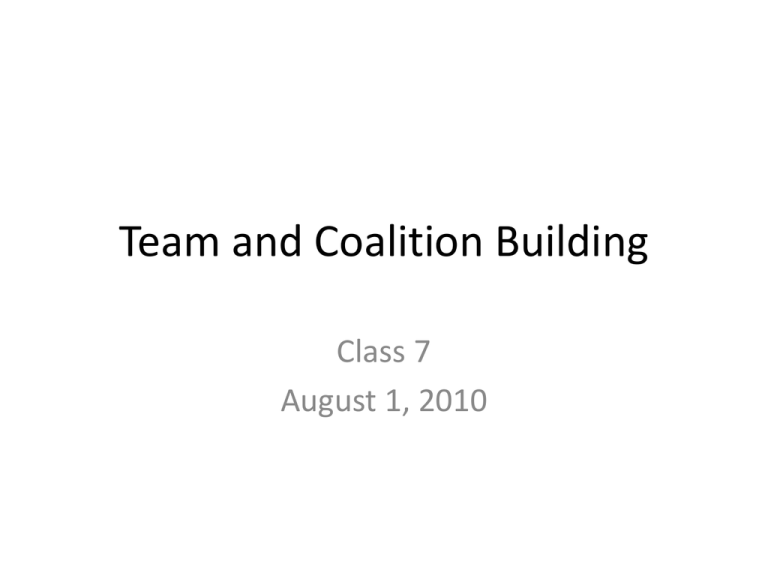
Team and Coalition Building Class 7 August 1, 2010 Forming and Working with Teams • How can managers work collaboratively with others both internally and outside the agency • Collaborative relationships: – Teams – Task Forces – Working with Collateral Organizations Importance of team building • Agencies move away from top-down to bottom-up decision making • Forming a team is one of the most effective methods of developing staff commitment • Team can produce results that are quantitatively better what an individual can produce Creating Effective Teams Characteristics of effective teams: • Communicate a shared vision • Deemphasize hierarchy • Encourage open communication • Develop trust in one another • Establish rules and behavioral norms • Make decisions by consensus Effective team leaders Characteristics that make good team leaders: **negotiating **communicating **agenda setting **goal development and action planning **creates a safe environment Handling Conflict on Teams • • • • • • • Avoid “groupthink” Most conflict relates to tasks and roles Uneven division of work Individuals forming cliques within the team Leaders determine the source of the conflict Encourage the airing of differences Use ground rules Individual Styles and Team Development • Contributor: task oriented; provides team with information • Collaborator: goal-oriented; open to new ideas; sees the big picture • Communicator: process-oriented; able to solve conflict and build relationships • Challenger: openly questions the goals and methods of team; encourages risk- taking and being open to new ideas Parker (1990) Stages of Team Development • Forming: establish a sense of security and direction • Conforming: becoming united and identifying roles; members become content with team membership • Storming: differentiation occurs and leads to conflict • Performing: functions at a highly effective level (Tuckman, 1965; Cameron & Whetten, 1991) Improving Team Effectiveness • US Department of Labor Guidelines: • • • • • Have clarity on goals of the team Clearly define roles Communicate clearly Be mindful of personality styles and stages Develop a plan for improvement Team Building Exercise 1. Identify a target population (e.g., street children, the elderly, the disabled, mentally ill) that need better social services 2. Come up with 3 major recommendations for government organizations in order to improve services for target population Team Building Exercise Continued 3. Reflect on Group Process: -leader or self-led? -was consensus used to come up with recommendations? -were you aware of the stage of the group? -were there different personality types operating in the group; did members take on different roles? -what made your group successful in achieving its goals? -how might the group process be improved? Task Forces • Carry out a specific assignment on a timelimited basis • Important to clarify tasks and roles • Staff involvement must be meaningful • If several task forces are organized need to be well-organized • Need to reintegrate staff once work is complete Coalition Building Collateral Relationships • • • • Good compatibility Development of shared resources Cultural compatibility Common domain of activities and target population • Communicative infrastructure • Trust! Areas of Collaboration Joint Planning • Administrative services • Service Coordination • Personnel Coordination • Financial Coordination Questions for Discussion • You are a neighborhood grassroots advocacy organization dedicated to changing living conditions in your community. Recently, you have been invited to join a coalition of agencies from the community to address the problem of overcrowding in urban areas. • What are the pros and cons of joining the coalition? • If you join, how will you preserve your autonomy? Questions for Discussion • Several business and community leaders have proposed creating a community coalition to conduct a community needs assessment in Hanoi’s Old Quarter. • Based on results, the coalition would develop the community’s agenda for addressing the highest priorities. • What are the pros and cons of participating in a process that determines the community’s focus and resource allocation?
